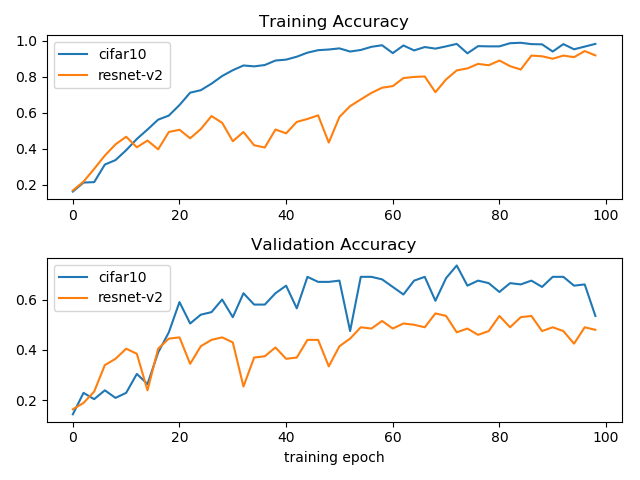keras project for audio deep learning
- The classifier ResNetV2AudioClassifier converts audio into mel-spectrogram and uses a simplified resnet DCnn architecture to classifier audios based on its associated labels.
- The classifier Cifar10AudioClassifier converts audio into mel-spectrogram and uses the cifar-10 DCnn architecture to classifier audios based on its associated labels.
- The classifier ResNet50AudioClassifier converts audio into mel-spectrogram and uses the resnet-50 DCnn architecture to classifier audios based on its associated labels.
The classifiers differ from those used in image classification in that:
- they use ELU instead RELU.
- they have elongated max pooling shape (as the mel-spectrogram is elongated "image")
- Dropout being added
The audio classification uses Gtzan data set to train the music classifier to recognize the genre of songs.
The classification works by converting audio or song file into a mel-spectrogram which can be thought of a 3-dimension matrix in a similar manner to an image
To train on the Gtzan data set, run the following command:
cd demo
python cifar10_train.pyThe sample codes below show how to train Cifar10AudioClassifier to classify songs based on its genre labels:
from keras_audio.library.cifar10 import Cifar10AudioClassifier
from keras_audio.library.utility.gtzan_loader import download_gtzan_genres_if_not_found
def load_audio_path_label_pairs(max_allowed_pairs=None):
download_gtzan_genres_if_not_found('./very_large_data/gtzan')
audio_paths = []
with open('./data/lists/test_songs_gtzan_list.txt', 'rt') as file:
for line in file:
audio_path = './very_large_data/' + line.strip()
audio_paths.append(audio_path)
pairs = []
with open('./data/lists/test_gt_gtzan_list.txt', 'rt') as file:
for line in file:
label = int(line)
if max_allowed_pairs is None or len(pairs) < max_allowed_pairs:
pairs.append((audio_paths[len(pairs)], label))
else:
break
return pairs
def main():
audio_path_label_pairs = load_audio_path_label_pairs()
print('loaded: ', len(audio_path_label_pairs))
classifier = Cifar10AudioClassifier()
batch_size = 8
epochs = 100
history = classifier.fit(audio_path_label_pairs, model_dir_path='./models', batch_size=batch_size, epochs=epochs)
if __name__ == '__main__':
main()After training, the trained models are saved to demo/models.
- The training accuracy reached over 80% after 29 epochs.
- The training accuracy reached over 90% after 38 epochs.
- The training accuracy after 100 epochs is 98.13%, with validation accuracy of 71%.
Currently ResNet50AudioClassifier is too expensive to run on my hardware (OOM exception from GPU). Below compares training quality of ResNetV2AudioClassifier and Cifar10AudioClassifier:
To test the trained Cifar10AudioClassifier model, run the following command:
cd demo
python cifar10_predict.pyThe sample codes shows how to test the trained Cifar10AudioClassifier model:
from random import shuffle
from keras_audio.library.cifar10 import Cifar10AudioClassifier
from keras_audio.library.utility.gtzan_loader import download_gtzan_genres_if_not_found, gtzan_labels
def load_audio_path_label_pairs(max_allowed_pairs=None):
download_gtzan_genres_if_not_found('./very_large_data/gtzan')
audio_paths = []
with open('./data/lists/test_songs_gtzan_list.txt', 'rt') as file:
for line in file:
audio_path = './very_large_data/' + line.strip()
audio_paths.append(audio_path)
pairs = []
with open('./data/lists/test_gt_gtzan_list.txt', 'rt') as file:
for line in file:
label = int(line)
if max_allowed_pairs is None or len(pairs) < max_allowed_pairs:
pairs.append((audio_paths[len(pairs)], label))
else:
break
return pairs
def main():
audio_path_label_pairs = load_audio_path_label_pairs()
shuffle(audio_path_label_pairs)
print('loaded: ', len(audio_path_label_pairs))
classifier = Cifar10AudioClassifier()
classifier.load_model(model_dir_path='./models')
for i in range(0, 20):
audio_path, actual_label_id = audio_path_label_pairs[i]
predicted_label_id = classifier.predict_class(audio_path)
print(audio_path)
predicted_label = gtzan_labels[predicted_label_id]
actual_label = gtzan_labels[actual_label_id]
print('predicted: ', predicted_label, 'actual: ', actual_label)
if __name__ == '__main__':
main()- Step 1: Change tensorflow to tensorflow-gpu in requirements.txt and install tensorflow-gpu
- Step 2: Download and install the CUDA® Toolkit 9.0 (Please note that currently CUDA® Toolkit 9.1 is not yet supported by tensorflow, therefore you should download CUDA® Toolkit 9.0)
- Step 3: Download and unzip the cuDNN 7.4 for CUDA@ Toolkit 9.0 and add the bin folder of the unzipped directory to the $PATH of your Windows environment
To pre-generate the mel-spectrograms from the audio files for classification, one can also first run the following scripts before starting training, which will make the training faster:
cd demo/utility
python gtzan_loader.pyThe audio processing depends on librosa version 0.6 which depends on audioread.
If you are on Windows and sees the error "audioread.NoBackend", go to ffmpeg and download the shared linking build, unzip to a local directory and then add the bin folder of the ffmpeg to the Windows $PATH environment variable. Restart your cmd or powershell, Python should now be able to locate the backend for audioread in librosa
To export the trained keras model as tensorflow graph model file, run the following command:
cd demo
python cifar10_tensorflow_export_model.pyThe script demo/cifar10_tensorflow_export_model.py export the trained model as demo/mdoels/tensorflow_models/cifar10/cifar10.pb
To test the exported tensorflow graph model file, run the following command:
cd demo
python cifar10_tensorflow_classifier.pyThe script demo/cifar10_tensorflow_classifier.py uses pure tensorflow code to load the cifar10.pb and uses it to predict genres of the songs
